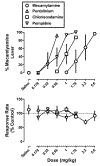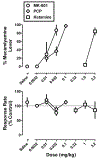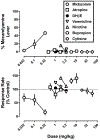Discriminative stimulus effects of mecamylamine and nicotine in rhesus monkeys: Central and peripheral mechanisms
- PMID: 30738085
- PMCID: PMC6788799
- DOI: 10.1016/j.pbb.2019.02.002
Discriminative stimulus effects of mecamylamine and nicotine in rhesus monkeys: Central and peripheral mechanisms
Abstract
Mecamylamine is a non-competitive nicotinic acetylcholine receptor (nAChR) antagonist that has been prescribed for hypertension and as an off-label smoking cessation aid. Here, we examined pharmacological mechanisms underlying the interoceptive effects (i.e., discriminative stimulus effects) of mecamylamine (5.6 mg/kg s.c.) and compared the effects of nAChR antagonists in this discrimination assay to their capacity to block a nicotine discriminative stimulus (1.78 mg/kg s.c.) in rhesus monkeys. Central (pempidine) and peripherally restricted nAChR antagonists (pentolinium and chlorisondamine) dose-dependently substituted for the mecamylamine discriminative stimulus in the following rank order potency (pentolinium > pempidine > chlorisondamine > mecamylamine). In contrast, at equi-effective doses based on substitution for mecamylamine, only mecamylamine antagonized the discriminative stimulus effects of nicotine, i.e., pentolinium, chlorisondamine, and pempidine did not. NMDA receptor antagonists produced dose-dependent substitution for mecamylamine with the following rank order potency (MK-801 > phencyclidine > ketamine). In contrast, behaviorally active doses of smoking cessation aids including nAChR agonists (nicotine, varenicline, and cytisine), the smoking cessation aid and antidepressant bupropion, and the benzodiazepine midazolam did not substitute for the discriminative stimulus effects of mecamylamine. These data suggest that peripheral nAChRs and NMDA receptors may contribute to the interoceptive stimulus effects produced by mecamylamine. Based on the current results, the therapeutic use of mecamylamine (i.e., for smoking or to alleviate green tobacco sickness) should be weighed against the potential for mecamylamine to produce interoceptive effects that overlap with another class of abused drugs (i.e., NMDA receptor agonists).
Copyright © 2019 Elsevier Inc. All rights reserved.
Figures




Similar articles
-
Pharmacologic characterization of a nicotine-discriminative stimulus in rhesus monkeys.J Pharmacol Exp Ther. 2012 Jun;341(3):840-9. doi: 10.1124/jpet.112.193078. Epub 2012 Mar 21. J Pharmacol Exp Ther. 2012. PMID: 22438471 Free PMC article.
-
The contribution of α4β2 and non-α4β2 nicotinic acetylcholine receptors to the discriminative stimulus effects of nicotine and varenicline in mice.Psychopharmacology (Berl). 2017 Mar;234(5):781-792. doi: 10.1007/s00213-016-4514-4. Epub 2016 Dec 27. Psychopharmacology (Berl). 2017. PMID: 28028600 Free PMC article.
-
Nicotine and bupropion share a similar discriminative stimulus effect.Eur J Pharmacol. 2002 May 17;443(1-3):113-8. doi: 10.1016/s0014-2999(02)01554-6. Eur J Pharmacol. 2002. PMID: 12044800
-
Green tobacco sickness: mecamylamine, varenicline, and nicotine vaccine as clinical research tools and potential therapeutics.Expert Rev Clin Pharmacol. 2019 Mar;12(3):189-195. doi: 10.1080/17512433.2019.1570844. Epub 2019 Jan 24. Expert Rev Clin Pharmacol. 2019. PMID: 30650314 Free PMC article. Review.
-
Discriminative stimulus effects of nicotine in humans.Handb Exp Pharmacol. 2009;(192):369-400. doi: 10.1007/978-3-540-69248-5_13. Handb Exp Pharmacol. 2009. PMID: 19184656 Review.
Cited by
-
More than Smoke and Patches: The Quest for Pharmacotherapies to Treat Tobacco Use Disorder.Pharmacol Rev. 2020 Apr;72(2):527-557. doi: 10.1124/pr.119.018028. Pharmacol Rev. 2020. PMID: 32205338 Free PMC article. Review.
-
Selective α3β4 Nicotinic Acetylcholine Receptor Ligand as a Potential Tracer for Drug Addiction.Int J Mol Sci. 2023 Feb 10;24(4):3614. doi: 10.3390/ijms24043614. Int J Mol Sci. 2023. PMID: 36835028 Free PMC article.
-
Acute nicotine reinforcement requires ability to discriminate the stimulus effects of nicotine.Exp Clin Psychopharmacol. 2022 Jun;30(3):253-268. doi: 10.1037/pha0000433. Epub 2020 Oct 29. Exp Clin Psychopharmacol. 2022. PMID: 33119384 Free PMC article. Review.
References
-
- Banerjee S, Punzi JS, Kreilick K, Abood LG (1990) [3H]mecamylamine binding to rat brain membranes. Studies with mecamylamine and nicotine analogues. Biochem Pharmacol 40: 2105–2110. - PubMed
-
- Besheer J, Palmatier MI, Metschke DM, Bevins RA (2004) Nicotine as a signal for the presence or absence of sucrose reward: a Pavlovian drug appetitive conditioning preparation in rats. Psychopharmacology (Berl) 172:108–117. - PubMed
-
- Caulfield MP, Higgins GA (1983) Mediation of nicotine-induced convulsions by central nicotinic receptors of the ‘C6’ type. Neuropharmacology. 22:347–351. - PubMed
Publication types
MeSH terms
Substances
Grants and funding
LinkOut - more resources
Full Text Sources

